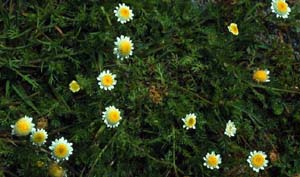Chrysanthemum coronarium (crown daisy) is an annual, growing to 60cm, with deeply-cut smooth leaves and erect stems with large (6cm) yellow, daisy-like flower heads in spring. A garden escape, it is found on wasteland in the northern wheatbelt and Perth. C. segetum (corn marigold) is also a yellow-flowered annual, growing to 45cm, which favours disturbed sites. It has divided leaves, and the stem is somewhat fleshy and thickened below the flowers. It has been recorded as naturalised around settlements between New Norcia and Busselton. Both are native to Europe.

Chrysanthemum
coronarium
, GK
Cichorium intybus (chicory) has sky-blue ray florets, making it easily recognisable in late spring when it is in flower. It is a stiffly-erect perennial, with deeply-toothed basal leaves and stem-clasping, entire, upper leaves. The leaves can be used in salads, while the dried roots are a coffee substitute. A native of Europe and western Asia, it has escaped from gardens onto roadsides and wasteland - often on calcareous soil - from Perth to Bunbury and is also occasionally seen in the western wheatbelt.

Cichorium
intybus, RC
Cirsium is a genus of thistles with spiny flowerheads and a fruit carried by a parachute of feathery bristles. C. vulgare (spear thistle) is a biennial to 1.5m with spiny leaves that continue down into the spiny winged stems. The heads are purple (4cm across) with rigid spiny bracts and are terminal in a flat-topped cluster. It is a widespread weed of farmland, roadsides and disturbed bushland from Geraldton to Esperance - most common near the south coast. It is native to Europe and western Asia, as is C. arvense (creeping thistle, Californian thistle) DP. This is a more slender plant, without winged stems, and the purple heads are only 2.5cm across. It reproduces by underground runners and is a serious agricultural weed, although now rarely encountered as it is an eradication target.

Cirsium
vulgare
, PH
Conyza
(fleabanes) are upright annuals from America. The flowers,
that do not have ray florets, are produced in summer, on
branched inflorescences that form a terminal
pyramid-shape.
C.
albida
(tall fleabane) has very leafy stems to 2m, that branch only
at the inflorescence, to form a pyramid of small,
greenish-white flowers. The whole plant is softly-hairy. It
is found on roadsides, disturbed wetlands and wasteland from
Perth to Albany.
C.
bonariensis
(flaxleaf fleabane) is a grey-hairy plant, usually not much
more than a metre tall, best distinguished by its stem which
branches below each pyramid of inflorescences, resulting in
a candelabra shape. It is a common weed of horticulture in
Perth and also common on disturbed sites such as roadsides
from Perth to Esperance; it has also been found near
Kununurra.
Two very similar plants,
C. parva
and C.
canadensis,are
found on roadsides, wasteland and in disturbed bushland from
Perth to Albany. Both are light yellow-green plants, with an
open, branching inflorescence but C.
canadensis
is hairier. Consult a specialist text for details. All are
from South America except C. canadensis, which is from North America.

Conyza
bonariensis
and C.
parva
, PH
Coreopsis
grandiflora
(American tickseed) is a short-lived perennial forming a
clump of dark green, deeply-lobed leaves, surmounted in
spring by 50cm tall stems bearing large (5cm) bright yellow
flower heads. A garden escape, occasionally seen on
roadsides between Perth and Albany. Native to North
America.
Cotula
is a Southern Hemisphere genus of about 80 species of annual
herbs. Six occur in Western Australia, two of them
introduced.
C.
bipinnata
(ferny cotula) is up to 20cm tall, has feathery divided
leaves and yellow flower heads without ray florets. It
flowers in spring and is found in damp wasteland and
disturbed wetlands from Kalbarri to Cape Riche.
C.
turbinata
(funnel weed) also flowers in spring and has feathery,
divided leaves, but the flower heads have small white ray
florets. Most distinctively, the stalk of the solitary
flower heads is swollen and hollow. It is found on sandy
soils, especially lawns, between Perth and Albany. Both are
native to South Africa. Two native species are weeds.

Cotula
turbinata
, RR
C. australis (carrot weed, common cotula) PP is a small, hairy annual with fern-like leaves, commonly
found in lawns in the south-west, often growing with (and
mistaken for) the prickly bindii (Solvia
pterosperma).
It produces small white to pale yellow flower heads on long,
slender stalks in spring, unlike S.
pterosperma,
whose prickly green flower heads are sessile amongst the
leaf bases.
C.
coronopifolia
(waterbuttons) is a fleshy, hairless annual or perennial
found in damp situations, which is often reported as a weed
of waterlogged areas in crops and pastures throughout the
south-west. It has bright-green, fleshy, irregularly-lobed
leaves to 4cm long, with the leaf base clasping the stem. It
flowers mainly in spring but also at other times of the year
if moisture is available, producing flat, bright yellow
flower heads that lack ray florets.

C. australis andC.
coronopifolia
, PH
Crepis
(hawksbeard) is a Northern Hemisphere genus of some 200
species. Three have become naturalised in Western Australia.
They all have yellow dandelion-like flowers produced in
early summer. C.
capillaris
(smooth hawksbeard) is a weed of roadsides and peppermint
woodland from Busselton to Albany. It is an upright,
branched annual. The flower heads are at first cylindrical,
becoming globular when mature. C. foetida (stinking hawksbeard) is an upright, somewhat sticky annual
to 50cm, more or less branched. The heads are terminal,
swollen at the base and constricted at the point where the
florets emerge. Found on roadsides, wasteland and in
disturbed bushland from Perth to Albany. Native to southern
Europe.
C.
vesicaria
(beaked hawksbeard) is an annual or short-lived perennial,
often much-branched, with oblong, deeply-lobed leaves. The
ray florets are yellow, the outer ones striped red-brown
beneath. Grows along rivers in the Metropolitan area. Native
to Europe.

Crepis
foetida, PH
